Black and Yellow Caterpillars (With Pictures) – Identification Guide
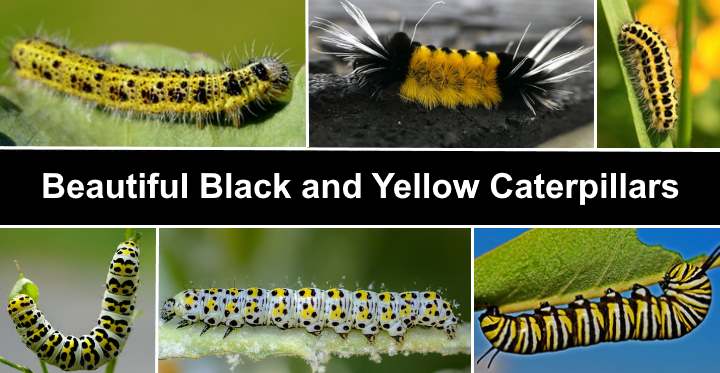
Black and yellow caterpillars are the larvae of butterflies or moths. Black and yellow caterpillars can be large or small crawling insects, and some may have furry bodies. Depending on the moth or butterfly species, the caterpillar could be black with yellow stripes or markings. Or some other caterpillars can be yellow with fuzzy bodies and black spines or horns. One thing in common with all black and yellow caterpillars is that they turn into spectacular winged insects.
Black and yellow caterpillars typically don’t resemble the butterflies or moths they turn into. For example, the black and yellow striped monarch caterpillar turns into the spectacular orange and black monarch butterfly. Or the black and yellow fuzzy spotted tussock caterpillar turns into the pretty brown mottled tiger moth.
This article is a guide to identifying various types of black and yellow caterpillars. In addition, descriptions and pictures of yellow and black caterpillars help you know what moth or butterfly species they become after metamorphosis.
Are Black and Yellow Caterpillars Poisonous?
Most black and yellow caterpillars are harmless and won’t sting you if you touch them. However, the yellow and black hairy spotted tussock caterpillar (Lophocampa maculata) has barbed spines that can cause skin irritation. Also, the monarch caterpillar (Danaus plexippus) and Cinnabar moth caterpillar (Tyria jacobaeae) contain toxins that could poison small birds or rodents.
Some types of black and yellow spiky caterpillars could look menacing. The horns at their head or tail end, eye-like markings, fuzzy bodies, and bright yellow colors, or black and yellow stripes are to ward off potential predators. But you generally don’t have to worry about black and yellow caterpillars being poisonous. However, it’s best to avoid touching any color of caterpillar that has spines or tufts of fine hairs.
Black and Yellow Caterpillar Identification
The way to identify black and yellow caterpillars is by looking at their colors, distinctive markings, six legs, prolegs (stumpy-looking legs), the presence of hairs or spines, and size. You can also identify some caterpillar species by the plant the caterpillar is feeding on. You can also measure their length for identification.
It’s also important to remember that all caterpillars go through several changes or instars. So, a caterpillar that’s just hatched from the pupa may look completely different from an adult caterpillar. This article looks at the identifying features of adult caterpillars in their last stages.
Black and yellow caterpillars are crawling, worm-like, leaf-eating caterpillars in the insect order Lepidoptera. Striped and horned yellow and black caterpillars can measure from less than an inch (2.5 cm) to 5.5” (14 cm) long.
Types of Black and Yellow Caterpillars (With Pictures)
Let’s look in detail at the stunning and fascinating types of yellow and black striped, fuzzy, hairy, and smooth caterpillars.
Monarch caterpillar (Danaus plexippus)

The monarch caterpillar has black, white, and yellow stripes on its body
The monarch caterpillar is a spectacular striped, black, yellow, and white caterpillar. The long, fat caterpillar is identifiable by its yellow, white and black stripes, white prolegs, and two black tentacles at either end of its body. The black and yellow monarch caterpillar grows between 1” and 1.7” (2.5 – 4.5 cm) long.
You will find the monarch caterpillar feeding on milkweed. Unfortunately, this diet makes monarch caterpillars one of the few poisonous black and yellow caterpillars.
Black and Yellow Caterpillar Identification
You can identify monarch caterpillars by their distinguishable black, yellow, and white stripes. Look for monarch caterpillars feeding on milkweed plants.
- Adult Stage: Develops into a monarch butterfly
- Caterpillar Feeds on: Milkweed plants (Asclepias species)
- Habitat: Found across North America, including gardens, meadows, and milkweed-rich areas
White-Marked Tussock Furry Horned Caterpillar (Orgyia leucostigma)
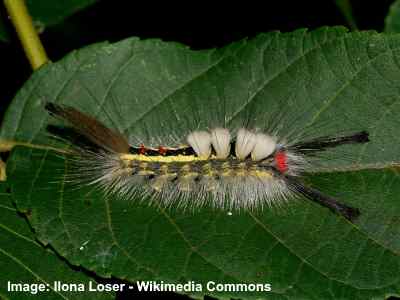
The furry white-marked tussock caterpillar is easily identified by its unique look
The white-marked tussock is a yellow and black furry caterpillar that turns into a giant brown moth. The spiny caterpillar is identified by its red head and tufts of yellowish hairs on a yellow and black body. You’ll also notice long black spines sticking out of the body. This unusual fuzzy caterpillar measures 1.3” (3.5 cm).
The white-marked tussock larva is a stinging caterpillar due to its urticating hairs that can cause allergic reactions in humans.
Black and Yellow Caterpillar Identification
The white-marked tussock caterpillar has characteristic tufts of yellowish-white stinging hairs, a black body with yellow stripes, and a red head.
- Adult Stage: Develops into a white-marked tussock moth
- Caterpillar Feeds on: Various deciduous trees and shrubs
- Habitat: Commonly found in North American forests, woodlands, and urban areas
Yellow Spotted Tussock Moth Caterpillar (Lophocampa maculata)
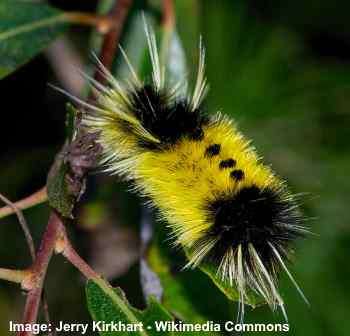
The yellow-spotted tussock caterpillar has a distinctive look with its yellow and black hairs
The yellow-spotted tussock is a fuzzy yellow and black caterpillar that looks like a giant bumblebee. The identifiable features of this tufty caterpillar are its furry black ends and wide yellow band around the body’s middle. You’ll also notice thin tufts of white hairs sticking out from its ends.
Although not poisonous, the spines on the black and yellow caterpillar can give you a nasty sting if you handle one.
Black and Yellow Caterpillar Identification
You can easily identify the yellow-spotted tussock by its distinctive wide black and yellow fuzzy bands and tufts of white hairs. These caterpillars are found feeding on oak, willow, maple, and alder leaves.
- Adult Stage: Develops into the yellow-spotted tussock moth
- Caterpillar Feeds on: Various plants, including deciduous trees and shrubs
- Habitat: Found in North America, often in woodlands, gardens, and urban areas
Six-Spot Burnet Caterpillar (Zygaena filipendulae)
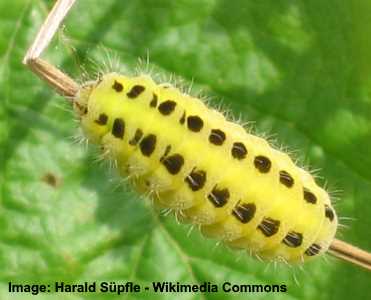
The six-spot burnet caterpillar has yellow body with black markings and small spikes
The six-spot burnet caterpillar is a fat yellow and black caterpillar. Native to the United Kingdom, this caterpillar measures about 0.8” (2 cm) long. Up close, you’ll notice tufts of spiny hairs covering the pale yellow and black segments.
This rare yellow and black caterpillar turns into a stunning black moth that flies in the daytime. The name “six-spot” burnet comes from the six red dots on the pretty butterfly’s glossy black wings.
Black and Yellow Caterpillar Identification
To help identify the six-spot burnet caterpillar, look for horizontal lines of black patterns on a pale, almost translucent yellow body.
- Adult Stage: Develops into a six-spot burnet moth
- Caterpillar Feeds on: Common bird’s-foot-trefoil and other leguminous plants
- Habitat: Common in meadows and grasslands across Europe
Queen Caterpillar (Danaus gilippus)

Queen Caterpillar has black and white stripes with yellow markings
The queen butterfly caterpillar is a sizeable black caterpillar with yellow dots, white stripes, and black tentacles. Related to the monarch caterpillar, this smooth caterpillar has a black head with white rings. The stripes are typically white, but they can be yellow, blue, green, or brown.
After emerging from its pupal stage, this black, white, and yellow striped caterpillar becomes a spectacular red butterfly.
Black and Yellow Caterpillar Identification
Identification of the queen caterpillar is by its six black fleshy tentacles, black body with white transverse bands, and two large yellow dots on each segment.
- Adult Stage: Develops into a queen butterfly
- Caterpillar Feeds on: Milkweed plants (Asclepias species)
- Habitat: Found in various regions, including North, Central, and South America, in areas with milkweed plants
Catalpa Sphinx (Ceratomia catalpae)
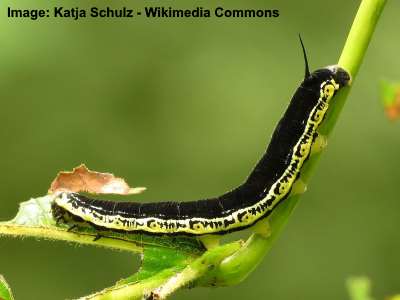
A mature Catalpa Sphinx caterpillar has a black body with yellow markings along each side
The catalpa caterpillar is a shiny jet black as it matures. Immature larvae are usually a light color with few markings. They become darker until they are pure black. Another identifying feature is their yellow markings along each side. These join together to become a yellow row on each side of the caterpillar.
Also called the Catawba worm, this black and yellow caterpillar has black dots along its sides. Catalpa caterpillars measure up to 2” (5 cm) long. They have a black head and tapered tail end.
You will find catalpa worms feeding on native catalpa trees or cigar trees in states such as Texas, Florida, Maine, and Iowa. The worm-like yellow and black caterpillars turn into large brown catalpa sphinx moths.
Black and Yellow Caterpillar Identification
To help recognize the catalpa caterpillar, look for the black body with yellow and black markings along the sides.
- Adult Stage: Develops into a catalpa sphinx moth
- Caterpillar Feeds on: Catalpa tree leaves (Catalpa species)
- Habitat: Commonly found in eastern North America, often on catalpa trees
Giant Sphinx caterpillar (Pseudosphinx tetrio)
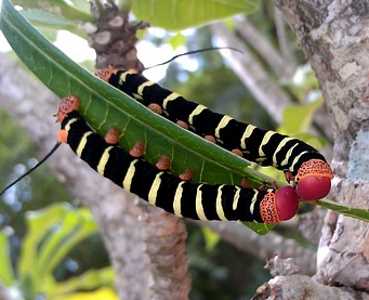
The yellow and black striped Giant Sphinx caterpillar has red/orange head and tail
The giant sphinx caterpillar is a sizeable black caterpillar with yellowish stripes around its segments. This giant caterpillar has identifiable orange prolegs, a red-orange head, and black horns at its orangey tail. Giant sphinx caterpillars grow up to 6” (15 cm) long.
The giant sphinx is a poisonous yellow and black caterpillar if small animals or birds eat it. Also, it has barbed, stinging hairs and has been known to bite if trapped.
Black and Yellow Caterpillar Identification
The giant sphinx has distinguishable yellow stripes on its jet-black body and an orange tail, head, and prolegs to help identify this enormous caterpillar.
- Adult Stage: Develops into a gray-brown moth species
- Caterpillar Feeds on: Primarily on tropical plants, including members of the nightshade family
- Habitat: Native to tropical and subtropical regions, found in areas with suitable host plants
Zebra Caterpillar (Melanchra picta)
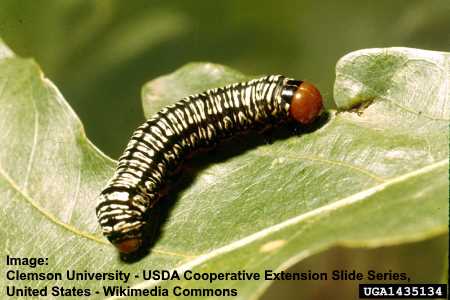
The black and yellow striped zebra caterpillar can be identified by its reddish-brown head
The zebra caterpillar is recognizable by its noticeable black and yellow stripes running lengthwise. As an unusual type of caterpillar, there are also thinner black stripes around the segments, giving the caterpillar a zebra-like pattern. In addition, the zebra caterpillar’s underside is reddish-brown. These black and yellow striped caterpillars measure up 1.4” to 1.6” (3.5 – 4 cm) long.
Black and Yellow Caterpillar Identification
To identify a zebra caterpillar, look for the broad creamy-yellow stripes and thinner black stripes along the length of the medium-sized caterpillar.
- Adult Stage: Develops into an American noctuid moth
- Caterpillar Feeds on: Various herbaceous plants and grasses
- Habitat: Found across North America, including gardens, fields, and grasslands
Common Sheep Moth Caterpillar (Hemileuca eglanterina)
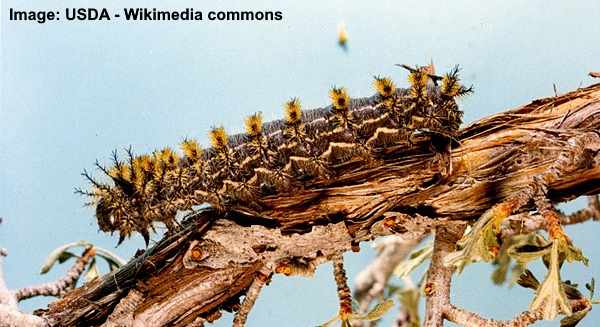
The common sheep moth caterpillar has dark body with yellow spines
The common sheep moth caterpillar is menacing-looking with a brownish-black body and tufts of black spiky and yellow or orange spines. You will find this unusual caterpillar feeding on the leaves of bitter cherry, bitterbrush, wild roses, and mountain lilac.
This unusual-looking black and yellow caterpillar turns into a spectacular orange or pink moth.
Black and Yellow Caterpillar Identification
Look for whorls of yellowish or orange tufts on the back of this black caterpillar to help identify it.
- Adult Stage: Develops into a common sheep moth
- Caterpillar Feeds on: Leaves of various host plants
- Habitat: Commonly found in western North America, including meadows, forests, and grasslands
Yellow and Black Cinnabar Caterpillar (Tyria jacobaeae)

The cinnabar caterpillar has yellow and black stripes with fine hairs on its body
The cinnabar caterpillar is a stunning caterpillar with yellow and black stripes. You will also notice that thin hair-like black or white spines grow sparsely on its body. The bright yellow and black colors act as a warning to predators not to eat this poisonous caterpillar.
You will find the yellow and black striped cinnabar caterpillar feeding on ragwort leaves. The yellow and black caterpillar transforms into a stunning black and red moth.
Black and Yellow Caterpillar Identification
Look for a jet-black and yellow striped caterpillar that grows up to 1.2” (3 cm) long to identify the cinnabar caterpillar.
- Adult Stage: Develops into a cinnabar moth
- Caterpillar Feeds on: Ragwort plants (Jacobaea vulgaris)
- Habitat: Native to Europe and Asia, often in meadows, grasslands, and open areas
Brown-Hooded Owlet (Cucullia convexipennis)
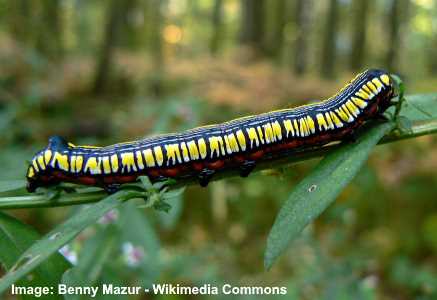
The brown hooded owlet caterpillar has black body with yellow stripes and red dots
The colorful, brown-hooded owlet caterpillar is a shiny black caterpillar with short yellow stripes and white markings along its sides. You will also notice a horizontal red line running lengthwise just above the glossy black legs. Also called the calico paint caterpillar, it has a shiny black head with yellow markings.
Black and Yellow Caterpillar Identification
The brown-hooded owlet caterpillar is identified by its yellow and white markings in a wide horizontal band along the body. The small black caterpillar measures up to 1” (2.5 cm) long.
- Adult Stage: Develops into a brown-hooded owlet moth
- Caterpillar Feeds on: Various herbaceous plants
- Habitat: Found in North America, including gardens, meadows, and open woodlands
Black Swallowtail Caterpillar (Papilio polyxenes)
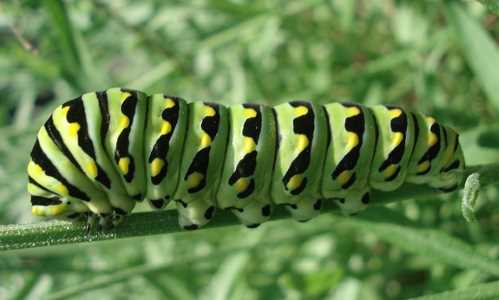
A mature black swallowtail caterpillar has green body with black stripes and yellow dots
The black swallowtail caterpillar is a green caterpillar with black and yellow stripes. The black stripes traversing the caterpillar’s segments have yellow dots. You will also notice that the prolegs are white or green with black and yellow markings.
This caterpillar is an example of butterfly larvae that change appearance as they mature. Young larvae are black caterpillars with a white band around the middle.
Black and Yellow Caterpillar Identification
The identifying characteristic of the black swallowtail caterpillar is the black stripes and yellow dots on a bright green body.
- Adult Stage: Develops into a black swallowtail butterfly
- Caterpillar Feeds on: Plants in the carrot family, including parsley and dill
- Habitat: Commonly seen in gardens, meadows, and fields across North America
Yellownecked caterpillar (Datana ministra)
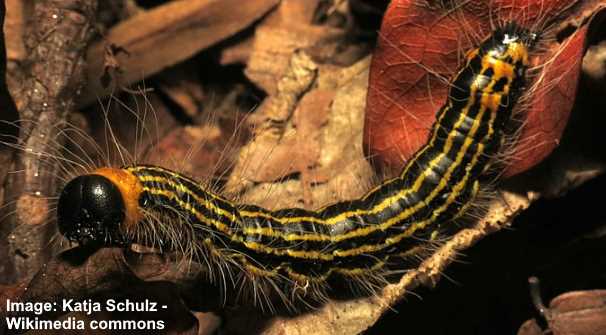
Yellownecked caterpillar has black and yellow stripes along its hairy body
The yellownecked caterpillar is a black caterpillar with long yellow stripes running along the length of the body. You’ll also notice that the hairy caterpillar has white feathery spines, yellowish and black legs, and a black head. The yellownecked caterpillar curls its body if threatened, creating a distinctive “U” shape.
Black and Yellow Caterpillar Identification
To identify a yellownecked caterpillar, look for the longitudinal yellow stripes on a black hairy body and characteristic yellow and black feet.
- Adult Stage: Develops into a moth species in the family Notodontidae
- Caterpillar Feeds on: Various deciduous trees, such as walnut and hickory
- Habitat: Found in eastern North America, often in forests and wooded areas
Mullein Moth Caterpillar (Cucullia verbasci)
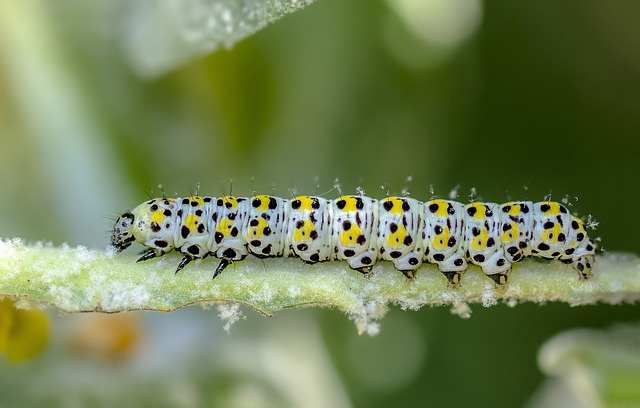
The beautiful mullein moth caterpillar is identified by its white or pale green body with black and yellow spots
The mullein moth caterpillar is an eye-catching long, fat caterpillar with yellow circles and black dots on a white or pale green body. The bright colors of this 2” (5 cm) long caterpillar make it easy to spot it feeding on Buddleia plant leaves. Mullein moth caterpillars are seen in July and August and can severely defoliate bushes.
Black and Yellow Caterpillar Identification
The yellow, black, and white Mullein moth caterpillar is easy to identify due to its black and yellow markings on a white or pale grayish-green body.
- Adult Stage: Develops into a mullein moth
- Caterpillar Feeds on: Mullein plants (Verbascum species)
- Habitat: Found in North America, often in fields, meadows, and disturbed areas
Grapeleaf Skeletonizer Caterpillar (Harrisina americana)
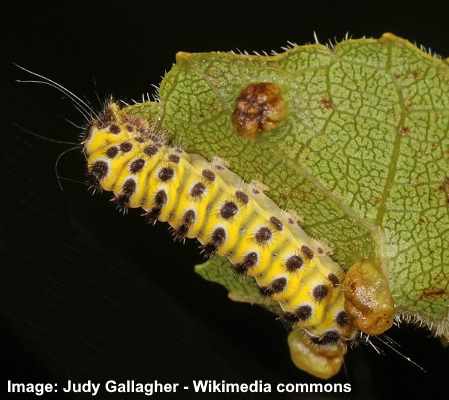
The grapeleaf skeletonizer has yellow body with black dots and small irritating hairs
The grapeleaf skeletonizer has yellow stripes and lines of black dots that help to identify this stout yellow caterpillar. You can find the leaf-munching pests on the underside of grapevine leaves. A characteristic trait of these caterpillars is that they line up in a row when feeding.
Although not a poisonous yellow and black caterpillar, the grapeleaf skeletonizer is covered in irritating hairs that can give you a nasty rash.
Black and Yellow Caterpillar Identification
The black and yellow grapeleaf skeletonizer caterpillar can be identified by its bands of black dots.
- Adult Stage: Develops into a moth species in the family Zygaenidae
- Caterpillar Feeds on: Grapevine leaves (Vitis species)
- Habitat: Native to North America, commonly on grapevines in vineyards and natural areas
Redhumped Caterpillar (Schizura concinna)
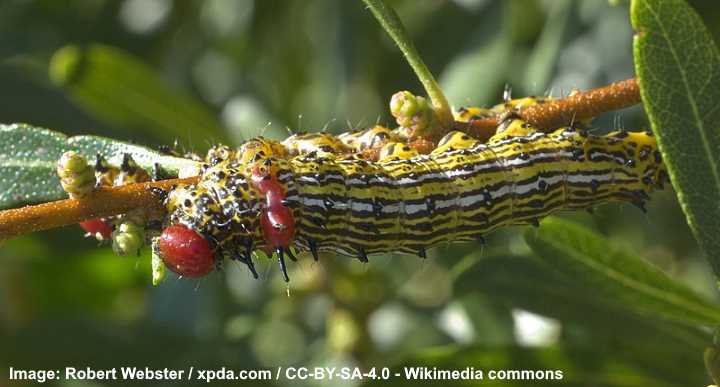
The attractive-looking redhumped caterpillar has yellow, black and white striped body with red head
The redhumped moth caterpillar has a bright yellow body with black and white horizontal stripes and black lines. The common name of this striped, yellow caterpillar comes from its distinguishable red humps on its back. You can spot yellow and black redhumped caterpillars feeding in groups on cottonwood, fruit trees, willow trees, and walnut trees.
Black and Yellow Caterpillar Identification
The identifiable features of the redhumped caterpillar are its yellow and black stripes, short, black fleshy tentacles, red head, and red humps.
- Adult Stage: Develops into a moth species of the family Notodontidae
- Caterpillar Feeds on: Various deciduous trees, including oaks and cherries
- Habitat: Common in North America, often in woodlands and gardens
American Dagger Caterpillar (Acronicta americana)
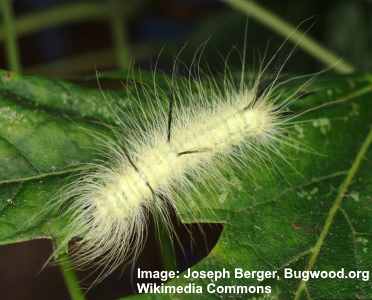
The American dagger caterpillar is identified by its yellow-whitish hairy look with black tuft on the back
The American dagger caterpillar is covered in fine, yellow hairs and two pairs of long, black hair-like spines on its back, and one at its tail. The pale yellow hairy caterpillar has a recognizable glossy black head. The dagger moth caterpillar is commonly found on hickory, birch, maple, oak, and poplar trees.
After emerging from the pupa, the furry yellow caterpillar turns into a majestic brown moth.
Black and Yellow Caterpillar Identification
The yellow American dagger moth caterpillar has long, fine feathery hairs covering its body. Its length is 2” (5 cm) long and sometimes it causes skin irritation after handling it.
- Adult Stage: Develops into the American dagger moth
- Caterpillar Feeds on: Various deciduous trees and shrubs
- Habitat: Commonly found in North America, including forests and woodlands
Smeared Dagger Moth Caterpillar (Acronicta oblinita)
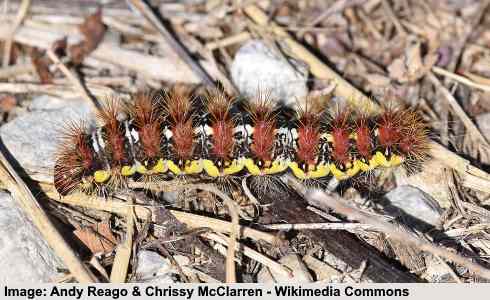
The smeared dagger caterpillar has poisonous spine tufts around its black, yellow and white body
The smeared dagger moth caterpillar has a black body, covered in tufts of spines, white markings on its back, and a yellow wavy line along both of its sides. As a method of defense, this dagger moth caterpillar has jaggy-looking tufts of white or reddish-brown spines. This spiny caterpillar can also give a nasty sting if you handle it.
You will usually find this pesky black and yellow caterpillar on fruit trees, shrubs, strawberry plants, willows, and oaks.
Black and Yellow Caterpillar Identification
To identify the smeared dagger moth caterpillar, look for the yellow longitudinal bands along the bristly black body with white markings on the back.
- Adult Stage: Develops into the smeared dagger moth
- Caterpillar Feeds on: Leaves of deciduous trees and shrubs
- Habitat: Native to North America, often in wooded areas
Fall Webworm (Hyphantria cunea)
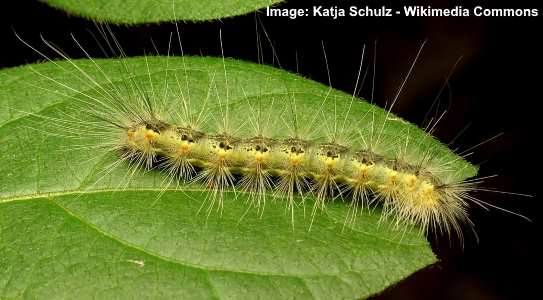
The fall webworm is a type of a small yellow hairy caterpillar with black dots and long spikes
Fall webworms come in a wide range of colors. Some of these small fuzzy caterpillars can be pale yellow with black dots, and others can be dark gray or green with light markings. Each segment of these insects has a black dot and tufts of yellow or white bristles. The yellowish hairy larvae create tent-like structures, like the ones called tent caterpillars create.
These yellow hairy caterpillars love to munch their way through leaves on walnut, cherry, crabapple, and other deciduous trees
Black and Yellow Caterpillar Identification
Identifying fall webworms is easy if you notice web nests hanging from the tips of hardwood tree branches in late summer and fall. The fall webworms measure 1.4” (3.5 cm) long, have a yellow, bristly body with black dots and long yellow spines.
- Adult Stage: Develops into a moth species in the family Erebidae
- Caterpillar Feeds on: Foliage of a wide range of deciduous trees
- Habitat: Widespread in North America, often found in trees with silken webs
White Flannel Moth Caterpillar (Norape ovina)
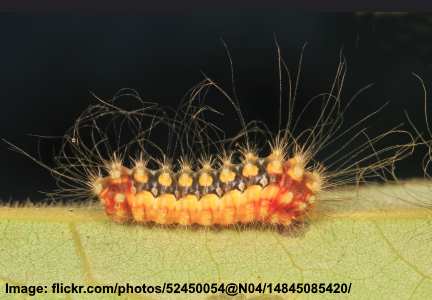
The venomous spines on the white flannel caterpillar can cause a painful sting
The white flannel moth caterpillar is a black fat venomous caterpillar with pairs of bright yellow dots on each segment and yellow underside. This stinging black and yellow caterpillar also has tufts of long feathery spines that can cause skin irritation. So, you should avoid touching it to prevent getting stung.
These yellow-dotted black caterpillars turn into spectacular white hairy moths.
Black and Yellow Caterpillar Identification
The white flannel moth caterpillar is identifiable by its yellow spots on a black body and tufts of stinging spines. The underside of the black and yellow caterpillar is also yellow, and it has yellow feet.
- Adult Stage: Develops into a white flannel moth
- Caterpillar Feeds on: Various shrubs and trees
- Habitat: Native to North America, often in forests and woodlands
Alder moth Caterpillar (Acronicta alni)

The black alder moth caterpillar has yellow bands on its back with black projections on the sides
The alder moth caterpillar is a black caterpillar with yellow stripes across its back. Looking up close, you’ll also notice that the black and yellow caterpillar has several black spikes and two pairs of wavy antennae-like projections. Fully grown, the distinctive black and yellow striped caterpillar measures 1.18” to 1.37” (30 – 35 mm) long.
These black and yellow leaf-eating caterpillars are commonly found munching through the foliage on deciduous trees. However, the immature larvae are hard to spot because they are black and white and resemble bird droppings. But as they grow, they become striped with yellow and black bands and club-tipped spikes.
After pupation, the black and yellow striped caterpillar becomes the alder moth. It’s a type of fuzzy moth with brown forewings featuring creamy mottled patterns and lighter-colored rear wings.
Black and Yellow Caterpillar Identification
The distinctive black and yellow alder moth caterpillar has vibrant yellow bands on a glossy black cylindrical body. An identifying feature is the paddle-like spikes on the side of its segments.
- Adult Stage: Develops into the alder moth
- Caterpillar Feeds on: Leaves of alder trees (Alnus species)
- Habitat: Common in North America, often in riparian areas near water bodies
Amaryllis Borer Caterpillar (Brithys crini)
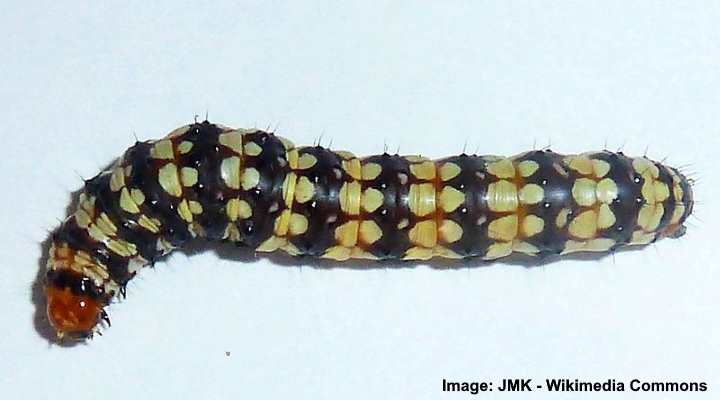
You can identify the amaryllis borer caterpillar by its yellow marking on its black body and reddish-brown head
The amaryllis borer caterpillar is a chunky black caterpillar covered with oval-shaped dull yellow spots forming bands between the segments. The black and yellow caterpillar also has a small rounded rusty brown head and fine setae sparsely covering its body. The sizable striped caterpillar matures around 1.75” (40 mm) long.
Also called the lily borer, crinum borer, or Kew arches, this plant-damaging black and pale-yellow caterpillar feeds on amaryllis and lily stems and leaves. The yellow-striped, black caterpillars are poisonous to birds and other insects that find their taste unpalatable. The caterpillars damage plants by boring into plant tissue leaving behind large holes.
Black and Yellow Caterpillar Identification
The amaryllis borer caterpillar is easily recognizable by its black body and pale-yellow bands around its segments. Pictures of the yellow and black caterpillar show small bristly spikes on its cigar-shaped body.
- Adult Stage: Develops into a moth species of the family Noctuidae
- Caterpillar Feeds on: Amaryllis plants (Amaryllis species)
- Habitat: Native to tropical and subtropical regions, often in gardens
Scarlet Tiger Moth Caterpillar (Callimorpha dominula)
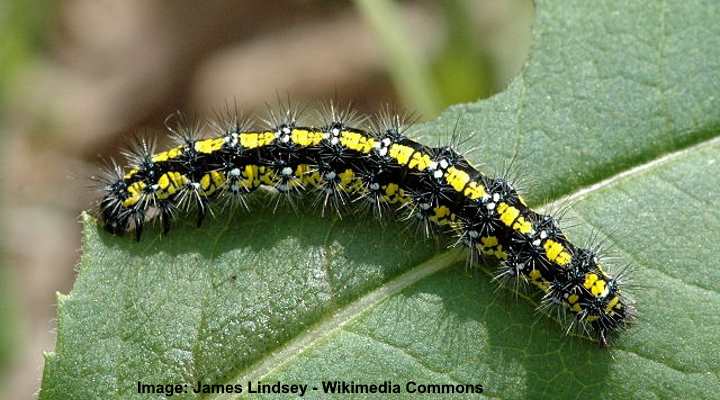
The large spiky scarlet tiger moth caterpillar has yellow and white bands running along its black body
The larva of the scarlet tiger moth caterpillar is a spiky black caterpillar with white-dotted yellow stripes running lengthwise. The black spikes on this black and yellow caterpillar appear in tufts around each segment. This caterpillar has a cylindrical body that grows up to 1.57” to 1.77” (40 – 45 mm) long.
Due to its large size and spiky appearance, this black caterpillar with yellow stripes feeds on a wide range of plants, including stinging nettle and common comfrey. The caterpillars emerge in early spring and overwinter in the ground before emerging the following spring.
After the larval stage, the scarlet tiger moth caterpillar becomes a black and red moth, characterized by yellow, red, and white dots on its black forewings.
Black and Yellow Caterpillar Identification
The scarlet tiger moth caterpillar is easily identified by its black cylindrical body, yellow stripes, white spots, and tufts of black spiny spikes.
- Adult Stage: Develops into a scarlet tiger moth
- Caterpillar Feeds on: Various herbaceous plants
- Habitat: Common in parts of Europe, often in gardens and meadows
Lily Borer Caterpillar (Diaphone eumela)
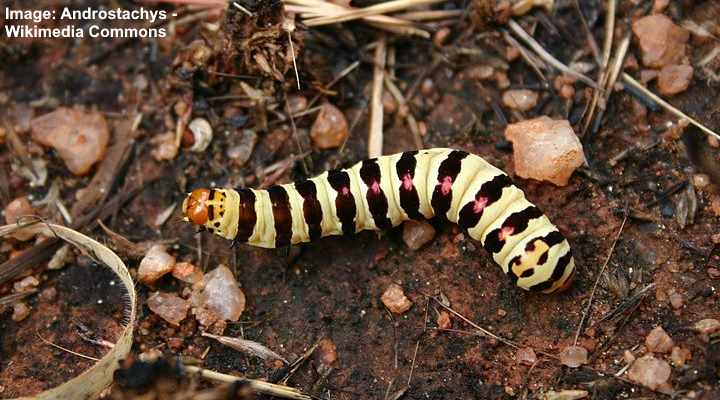
The striped black and pale yellow lily borer caterpillar has an orange head and can be found on lily and amaryllis plants
The brightly colored lily borer caterpillar is a yellow caterpillar with dark brown to black stripes around each segment. The yellow and black “bug” has a pale brown or orange head, a red dot in each black band, and a yellowish patch at its rear end. The yellow and black striped caterpillars measure up to 1.57” (40 mm).
Lily borer caterpillars emerge pale yellow with black stripes. As the colorful caterpillars grow, they develop orange spots that eventually give the yellow caterpillar a mottled black and reddish orange appearance. Lily borer caterpillars are related to the amaryllis borer species.
As the name suggests, these black-striped, yellow caterpillars are typically found on lily and amaryllis plants. The cigar-shaped larvae burrow into plant tissue, leaving tell-tale holes in the lily flower leaves and stems.
Black and Yellow Caterpillar Identification
The bright yellow and black lily borer caterpillar is identified by the dark bands around its yellow segments.
- Adult Stage: Develops into a moth species of the family Noctuidae
- Caterpillar Feeds on: Lily plants (Lilium species)
- Habitat: Native to parts of North America, often in gardens
Police Car Moth Caterpillar (Gnophaela vermiculata)

The black body of the police car moth caterpillar is dotted with yellow spots creating a broken line on its back
The larva of the police car moth is a spiky black caterpillar with bright yellow markings along its fuzzy body. Like many species of black caterpillars with spikes, the spines grow in tufts around each segment. Irregular yellow dots make up a broken lateral band of color.
Apart from grayish-black spikes and yellow spots, the distinctive black caterpillar body includes iridescent blue spots. In addition, a rounded reddish-brown head gives the yellow-spotted black caterpillar an unusual appearance. However, immature larvae are more yellow than black.
The police car moth caterpillar emerges from its silken cocoon as an eye-catching black and white moth — hence the name. This caterpillar moth is also called the green lattice moth larva. You will often find the spiky black caterpillar feeding on the nectar of herbaceous flowers.
Black and Yellow Caterpillar Identification
The police car moth is identified by a glossy-jet black spiky body with yellow and metallic blue spots and a reddish head.
- Adult Stage: Develops into a police car moth
- Caterpillar Feeds on: Various herbaceous plants
- Habitat: Native to North America, often in open areas and meadows
Cabbage White Caterpillar (Pieris brassicae)
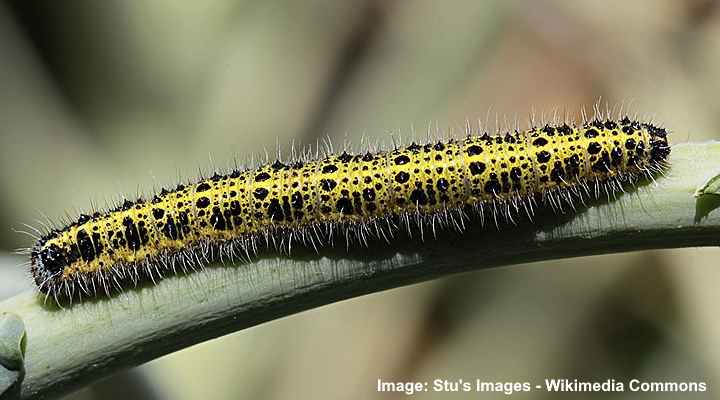
The large cabbage white caterpillar has a yellow body covered in black spots and fine white hairs
The cabbage white larva is a yellow caterpillar covered in fine setae and large to small black dots. The yellow and black slug-like caterpillar goes through different growth stages where its appearance changes. First, it turns from pale yellow to dark yellow before becoming grayish green and black before pupation.
The hairy yellow caterpillars with their brown heads grow 1.57” (40 mm) long. As the name implies, the yellowish-green, black spotted caterpillar feeds on cabbage and other plants in the genus Brassica. In addition, the large, plump caterpillars can decimate crops like Brussels sprouts, swede, turnip, cauliflowers, and kohlrabi.
The yellow and black caterpillars are the larvae of the large cabbage white, also called cabbage butterfly or cabbage white. The butterfly is characterized by its snow-white wings and brown margins at the tips.
Black and Yellow Caterpillar Identification
The cabbage white butterfly caterpillar is described as a fuzzy yellow caterpillar covered in black dots, white hairs, and black tubercles.
- Adult Stage: Develops into a cabbage white butterfly
- Caterpillar Feeds on: Cabbage family plants, including cabbage, broccoli, and mustard
- Habitat: Common in gardens and agricultural areas
Magpie Moth Caterpillar (Abraxas grossulariata)
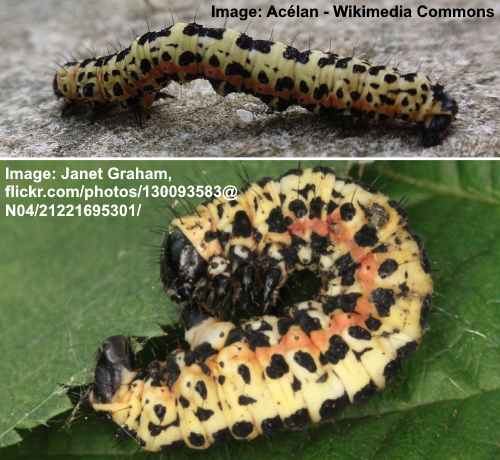
The magpie moth caterpillar can be identified by its pale yellow body, black spots and orange stripe on its sides
The magpie moth larva is identified as a pale-yellow caterpillar with broken black lateral stripes along its body and an orange stripe at the base of its abdomen. Up close, pictures of the yellow, black, and orange slug-like insect show it’s sparsely covered in short, fine black hairs.
A mature magpie moth caterpillar measures 1.18” (30 mm) long. A characteristic trait of the yellow and black caterpillar is its looping movement as it crawls over plant foliage and stems. The black-speckled yellow caterpillar typically feeds on the leaves of hawthorn, blackthorn, gooseberry, and Japanese spindle (Euonymus japonicus).
Black and Yellow Caterpillar Identification
The distinctive magpie moth caterpillar has black spots covering its creamy-yellow body. Additionally, a characteristic orange band runs laterally along the base of its abdomen.
- Adult Stage: Develops into a magpie moth
- Caterpillar Feeds on: Various herbaceous plants
- Habitat: Found in parts of Europe and Asia, often in gardens and woodlands
White-Lined Sphinx Moth Caterpillar (Hyles lineata)
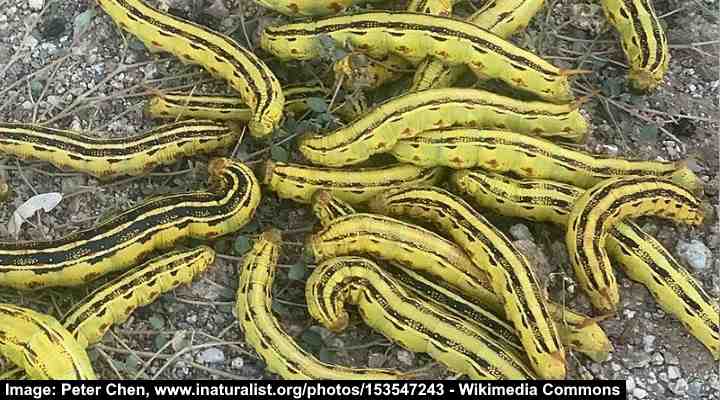
The white-lined sphinx caterpillar has many color variations depending on its growth stage, and can have a yellow body with black stripes lengthwise
The larva of the white-lined sphinx moth is a greenish-yellow caterpillar with black stripes running lengthwise. The large slug-like insect also has small triangular black markings and brownish spots on its sides. These large yellow and black caterpillars grow to 3.5” (88 mm) long.
The white-lined sphinx moth caterpillar can be challenging to identify because of several color variations. Depending on the climate, the slender, cylindrical larvae can be dark green with black and white dots or lime green with a black or orange spiked tail.
The yellow, black-striped caterpillars are common throughout gardens and deserts in North America. They feed on several plant species, including fuchsia, tomato, apple, elm, evening primrose, and grapes.
Black and Yellow Caterpillar Identification
The white-lined sphinx moth caterpillar has a distinctive light green-yellowish worm-like body with black lateral stripes and brownish-black markings along its back and sides.
- Adult Stage: Develops into a white-lined sphinx moth
- Caterpillar Feeds on: A wide range of plants, including various garden plants
- Habitat: Common in North and Central America, often in gardens and open areas
Grass Eggar Moth Caterpillar (Lasiocampa trifolii)
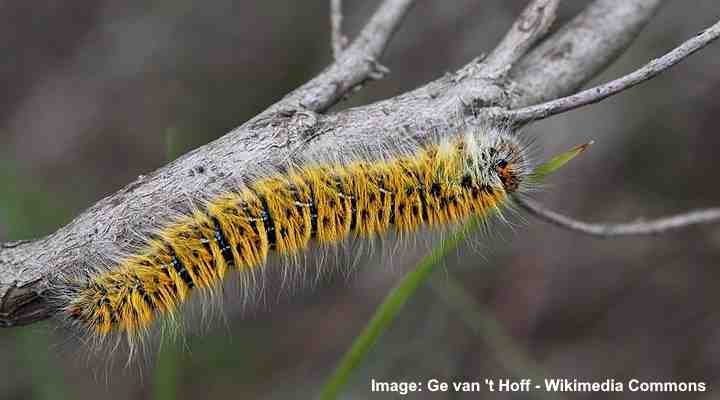
The long black body of the grass eggar moth caterpillar is covered with furry coat of yellow-orange hairs
The larva of the grass eggar moth is a fuzzy black caterpillar covered in fine yellowish-orange hairs. This unusual hairy black caterpillar also has a rounded head with faint orange markings. Depending on the species, the caterpillar can appear orange and black. At maturity, the grass eggar caterpillar grows 2.55” (65 mm) long.
Hairy yellow and black grass eggar moth caterpillars are active in late March and April. The voracious caterpillars feed on various species of ornamental grasses, shrubs, and deciduous trees. And the mature fuzzy caterpillars may live on peas, beans, and other plants in the genus Fabaceae.
After pupating, the black and yellow hairy caterpillar emerges as an attractive fuzzy brown moth. The russet-brown moths are active at night during August and September.
Black and Yellow Caterpillar Identification
The grass eggar moth caterpillar is a black-bodied, cylindrical caterpillar covered in yellowish-orange hairs. However, some species appear grayish-white with an orange lateral band on their backs.
- Adult Stage: Develops into a grass eggar moth
- Caterpillar Feeds on: Various grasses and herbaceous plants
- Habitat: Native to parts of Europe, often in grassy habitats
Buff-Tip Moth Caterpillar (Phalera bucephala)
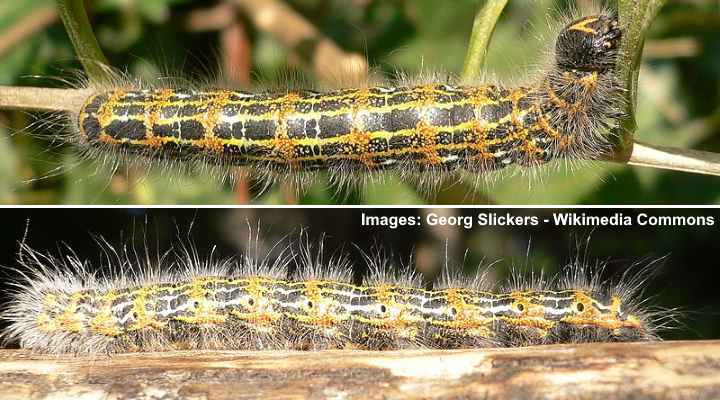
The large black body of the buff-tip moth caterpillar has yellow stripes and orange patches and is covered with fine hairs
The larva from the buff-tip moth is a soft-bodied, cylindrical-shaped black caterpillar with distinctive yellow stripes running lengthwise and orange patches around each segment. The easy-to-identify black and yellow striped caterpillar also has tufts of pale setae and a unique ‘V’ marking on a black globular head.
With its slender tube-shaped body, the buff-tip moth caterpillar measures 2” to 3” (50 – 75 mm) long. Its distinctive yellow, orange and black patterns are described as trellised, covering its body.
The unusual caterpillar is commonly found on many species of deciduous trees, including oak, beech, willow, and hazel. It’s good to note that the yellow and black caterpillar has irritating spines. Therefore, you should wear gloves when removing them from trees and shrubs.
Black and Yellow Caterpillar Identification
The buff-tip moth caterpillar is identified by its contrasting black, yellow and orange pattern, large black spherical head with a ‘V’ mark, and fine hairs covering its slug-like body.
- Adult Stage: Develops into a buff-tip moth
- Caterpillar Feeds on: Deciduous trees, including oak and hazel
- Habitat: Found in parts of Europe, often in woodlands
Toadflax Moth Caterpillar (Calophasia lunula)

The toadflax moth caterpillar can be identified by its attractive black and pale gray patterned body with yellow lines
The larva of the toadflax moth is a black caterpillar that develops bright yellow stripes and white dots. When fully mature, the plump worm-like insect has black, pale green, and yellow markings. The black and yellow caterpillar grows from being a tiny dark gray caterpillar 0.19” (5 mm) long to a large black and yellow worm-like insect 1.57” (40 mm) long.
The large, fat, black and yellow insect is a voracious feeder that can defoliate toadflax plants.
Toadflax moth caterpillars are relatively easy to identify despite their changing patterns between instars (growth stages). The caterpillars typically have a bluish-gray body with black markings and yellow stripes. However, as the black and yellow markings grow more prominent, the bluish-gray colors are less pronounced.
Black and Yellow Caterpillar Identification
The distinctive toadflax moth caterpillar has yellow stripes and jet-black markings on a bluish-gray cylindrical body.
- Adult Stage: Develops into the toadflax moth
- Caterpillar Feeds on: Toadflax plants (Linaria species)
- Habitat: Native to parts of Europe, often in grasslands and meadows
Virginia Ctenucha (Ctenucha virginica)
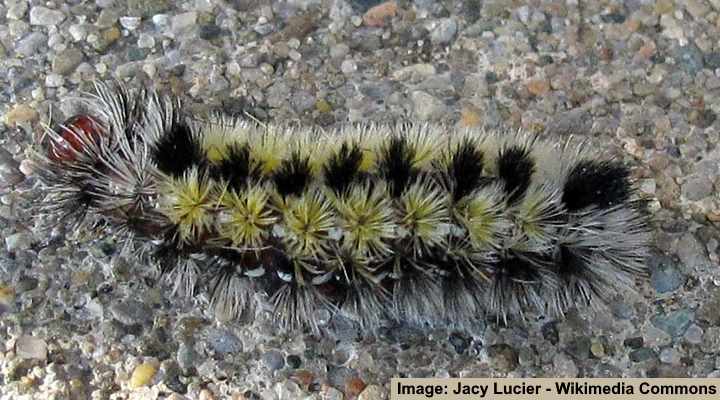
The small Virginia ctenucha caterpillar is covered with black, white and yellow tufts of hair and has a dark red head
The Virginia ctenucha moth larva is a small black and yellow fuzzy caterpillar covered in tufts of hair. In some instars, the caterpillar can appear black with a white band along its sides and clumps of yellow hairs on its body. Additionally, the furry caterpillar has a deep red globular head and red prolegs.
The black caterpillar with black and yellow hairy tufts measures 0.78” to 1” (20 – 25 mm) long. Native to North America, the hairy caterpillar can be found on several plant species, including sedges, irises, and various ornamental types of grass.
After its larval stage, the unusual black and yellow fuzzy caterpillar becomes a black moth with a striking metallic blue-green body, bright orange head, and feathery antennae.
Black and Yellow Caterpillar Identification
The Virginia ctenucha moth caterpillar is a small caterpillar covered in tufts of black, white, and yellow hairs.
- Adult Stage: Develops into a Virginia ctenucha moth
- Caterpillar Feeds on: Various grasses and herbaceous plants
- Habitat: Common in North America, often in open areas and meadows
Neighbor Moth Caterpillar (Haploa contigua)
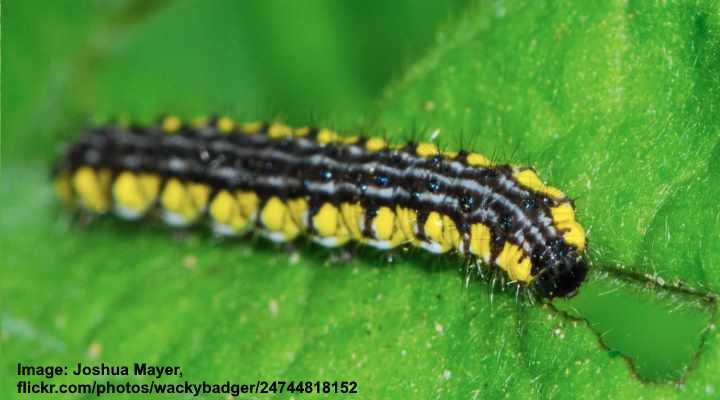
The black neighbor moth caterpillar has white lines on its back and thick yellow band on each side
The larva of the neighbor moth is a black caterpillar with a brightly-colored yellow band along each side and white lines along its back. The golden yellow and black insect also has tufts of black hair and fleshy spines sparsely covering its body. This slender, relatively small slug-like caterpillar grows up to 0.51” (13 mm) long.
The neighbor moth caterpillar is common throughout the United States, where it feeds on hazelnut, oak, and other native deciduous trees.
After pupating, this black and yellow caterpillar becomes the spectacular neighbor moth. The large cream-colored moth has striking dark brown markings on its wings.
Black and Yellow Caterpillar Identification
The neighbor moth caterpillar is a spiky black caterpillar with vibrant yellow lateral bands on its body and white thin lines on its back.
- Adult Stage: Develops into a moth species of the family Erebidae
- Caterpillar Feeds on: Various herbaceous plants
- Habitat: Found in North America, often in gardens and woodlands
Erasmia pulchella
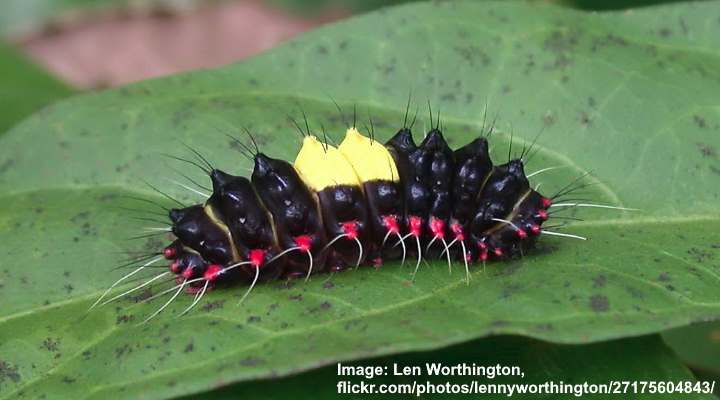
The Erasmia pulchella caterpillar can be easily identified by its shiny black body with yellow patch on the back, red dots on the sides and is covered with spikes
The Erasmia pulchella is a striking sizable black caterpillar with conspicuous yellow segments in its center. In addition, the easy-to-identify tropical caterpillar has a line of bright red dots, producing white spiky hairs. Also, each shiny black segment has fleshy tubercles, giving the unusual caterpillar a distinctive bumpy appearance.
This black and yellow caterpillar is a poisonous insect to any animal or bird that tries to eat it. This large caterpillar turns into a beautiful multi-colored moth with black, red, yellow, and blue colors.
Black and Yellow Caterpillar Identification
The glossy black Erasmia pulchella caterpillar is easily recognizable due to the bright yellow patch on its back and red spots along its sides.
- Adult Stage: Develops into a moth species of the family Zygaenidae
- Caterpillar Feeds on: Helicia cochinchinensis plant
- Habitat: Native to parts of Asia
Red Admiral Butterfly Caterpillar (Vanessa atalanta)
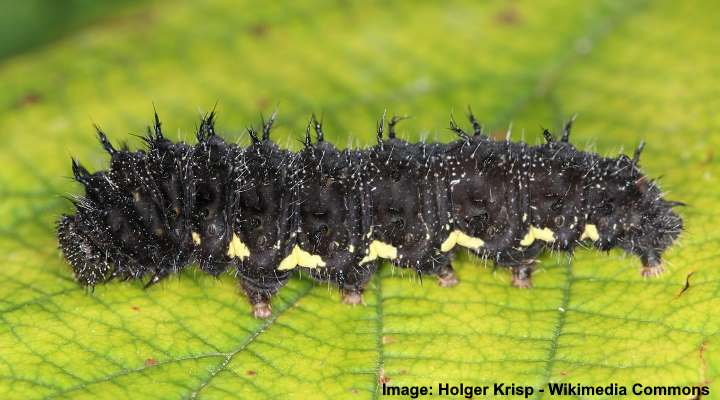
The red admiral caterpillar has black spiky body with tiny white dots and yellow patches along the sides
The larva of the red admiral butterfly is a spiky black caterpillar with distinctive yellow patches along its sides. Although primarily black, the caterpillar has white speckles covering its body along with short wispy spines. At maturity, the black caterpillar with yellow abdominal patches measures 1” (25 mm).
This native black caterpillar forms a tent where it lives and only emerges to feed. You can usually find the yellow-spotted black larvae on stinging nettle plants. Depending on the growth stage, the caterpillar can range in color from pale green to brown and black.
Black and Yellow Caterpillar Identification
The red admiral butterfly caterpillar is a black caterpillar with patches of yellow along its sides and covered in spiky spines, giving the insect a menacing appearance.
- Adult Stage: Develops into a red admiral butterfly
- Caterpillar Feeds on: Various nettles (Urtica species)
- Habitat: Common in North America and Europe, often in gardens and open areas
Related articles:
